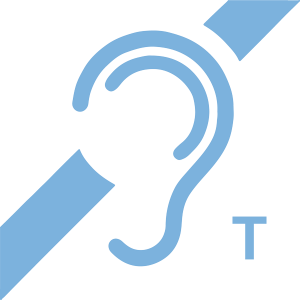About Induction Loops
Induction loops, also called hearing loops, are often the most practical, cheapest and lowest maintenance solution for giving good quality access to the hearing impaired, and is therefore becoming the most widely used solution around the world.
Once installed, a loop works for years without any maintenance cost for the owner of the venue. And not to forget – the hearing aid wearers do not need to pay for any extra receiver – the receiver is already built-in in their hearing aid! They just switch their hearing aids to T-position and enjoy the sound. That is real freedom! Read more about where and why!
How does it work?
Most hearing aids have a built in T-coil, a small wireless receiver, in addition to the regular microphone. When current passes through a wire (the loop cable), a magnetic field is generated around it. If a coil (the telecoil in the hearing aid) is brought within this magnetic field, a corresponding current is created. In technical language, the current is induced in the second wire, hence the term ”induction loop”. This electro-magnetic principle is the basis for hearing loops and the T-coil technique was invented in the 1950’s.
Step by step
The hearing loop driver is connected to the source of the sound, e.g. an audio system. The loop driver transforms the signal into an electric current in a loop cable surrounding the listening area. The loop current sets up a magnetic field which fluctuates with the audio.
When the hearing aid is switched on to the T-mode, the T-coil will pick up the signal from the magnetic field and convert it back into audible sound. The sound is clear and crisp and tailored for the individual’s hearing loss.
The idea of an assistive listening device
The single most important assistive device for people with hearing loss has been, still is and will be for the foreseeable future the hearing aid. But the hearing aid alone, how digital, high-tech and nice looking it might be, is not a sufficient tool for better hearing in every place and at every time. Sometimes it’s just not enough. When the hearing aid is insufficient the user gets alienated and cut-off of the social setting. To be unable to take part in the social interaction between people is a dreadful experience and it tend to make people alone and unhappy.
The idea of an assistive listening device is to assist whenever the hearing aid is not sufficient. In many cases the only way to increase speech intelligibility is to cut the distance between the sound source and the listener and at the same time reduce the present noise. This can basically be achieved with the use of three different techniques – induction (hearing) loop, radio (FM) or infrared (IR) systems.
Why is the induction loop system a great solution?
While FM and IR systems may have its advantages in certain personalized situations, only the induction loop can bring sound to everyone, everywhere and at once without the need of an extra receiver. The induction loop uses the built-in receiver in the hearing aid (T-coil) to transmit the sound without background noise through the personally adjusted hearing aid. Without any extra receiver and without any power consumption, the hearing aid user can experience crystal clear sound free of disturbing noise – without even telling anyone about their hearing loss. They just switch their hearing aids to T-position and enjoy the sound. That is real freedom! Bringing this freedom to the hearing aid users has always been the most important goal for us.
Everyone wins
An induction loop is clearly the most reliable option for the hearing aid user. We also believe it’s the best solution for the owner of the venue. Although a loop system takes a bit more commitment to get going, it will pay back many times over. A loop system is always active and ready to facilitate anyone with hearing aids as it’s not limited to the number of receivers you have, and minimum maintenance makes it the most cost effective solution. In public environments where people are just passing through, a loop system is the only practical solution.
FM and IR systems
Using FM or IR systems in public venues have pros and cons, both for the hearing aid user and for the owner of the venue.
The hearing aid user has to localize a possible supply of assistive listening devices, ask for help and thereby revealing that they have hearing loss. During the whole event the user has to wear a receiver/headset, which is not adjusted to their hearing loss, and that has to be returned after the event.
The owner of the venue has to organize someone who distributes the receivers and collects them after use. The receivers have to be stored, checked, charged, cleaned, repaired and replaced which eventually will lead to considerable maintenance costs.
On the other hand, FM and IR systems are easy to use and requires no installation. The FM and IR products that are specially designed to improve speech intelligibility for hearing aid users, make great assistive listening alternatives.
Induction loop systems can be used everywhere
In larger venues like stadiums and sports arenas, conference facilities and auditoriums, cinemas and theatres as well as in churches and other places of worship, the induction loop system is an optimal solution.
But also for smaller venues like meeting rooms and school classrooms a loop system can benefit the needs of the hearing impaired in a great way. In trains, trams and buses a loop system can also work with high performance.
This is the international sign for hearing loop (T-coil). This symbol indicates that the room is equipped with a hearing loop to make the premises accessible for hearing aid users.




